Team Members : Ayesha Mubeen S, Divya HS, Jyothi Kumari , Rakshitha Gowda
Project Guide : Mrs. Suhasini
Abstract of the project:
A fire detection and fire alarm system is number of devices working together to detect and warn people through visual and audio appliances when smoke, fire, carbon monoxide or other emergencies are present. These alarms may be activated from smoke detectors, and heat detectors. They may also be activated via Manual fire alarm activation devices such as manual call points or pull stations or automatically actuated devices which responds to any detectable physical changes associated with fire. We are proposing the new idea of using cameras and IOT technology to detect fire and analyze the visible effects of fire. Flame and smoke are two obvious vision features of fire. In order to detect fire the cause of fire, we have a camera included in that captures all fire images once fire is detected in any direction, A notification is sent to the admin immediately about the incident. We make use of the Internet Of Thing (IoT) for in this project. A Raspberry pi is used as a processing unit. Using this system, the reason of fire can be known remotely and it can be easy to take precautions in future.
Cost of the project: Rs.2,600/-
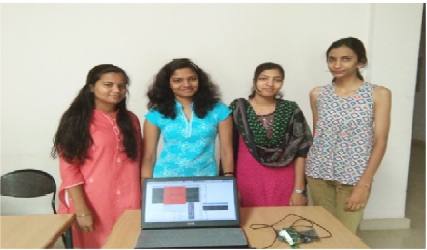
Team Members : Apoorva Nag N, M G Alakananda, M Pruthvi, Atharva ThaakurDesai
Project Guide : Rumana Anjum Asst Professor ,Dept of CSE, VVIET, Mysuru
Abstract of the project:
The basic issue in the online social network is to provide the ability for the user to manage the messages post on their wall. Online social networks offer only minimal assistance to avoid unwanted content displayed in the user wall. To enhance the support, a system is designed to filter unwanted messages and allow user to have direct control on the messages posted in the wall. It is achieved using flexible rule based system that allows the user to specify filtering rule for their wall. Machine Learning based soft classifier is employed to facilitate the content based filtering.
Cost of the project: Rs. 5,000/-
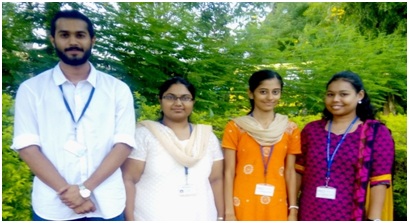
Team Members : Yashaswini M, Abhilash M J, Parvathamma D , Preetham H N
Project Guide : Ms. Akshatha M.
Abstract of the project:
To improve irrigation water use efficiency, reduce cost of irrigation water, using the design of wireless sensor network and Internet technology of farmland automatic irrigation control methods. Emphasis on an analysis of the routing protocol of sensor network nodes to achieve the system hardware and software design, middleware, and applications such as mobile phone or wireless PDA of internet of things, will constitute a variety of sensors intelligent network, thus enhancing the overall automation system and monitoring levels.
The final analysis of the network in the Internet is based on the agricultural plants of farmland water-saving irrigation system integrated approach. User by making use of mobile phones or wireless PDA can easily detect the soil moisture content by online monitoring and controlling the irrigation automation. Application results show that system, through the embedded control technology will improve the agricultural irrigation, Efficient usage of water and irrigation system automatization is generally low status, can well realize water saving.
Cost of the project: Rs. 4,000/-
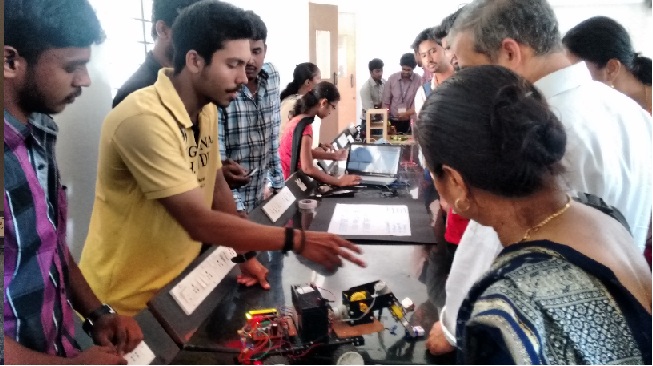
Team Members : Manohar.B, Sachin Srinivasan, Sharath Monappa, Sujay.H.V
Project Guide : Madhusudhan.G.K, Assistant Professor
Abstract of the project:
In Healthcare industry generally medical diagnosis is done mostly by doctor’s expertise and experience. Computer Aided Decision Support System plays a major role in medical field. With the growing research on disease predicting system, it has become important to categories the research outcomes and provides users with an accurate prediction of the heart disease. Data mining which is the fastest upgrading technology will be helpful in this process. The proposed system is a medical sector application and is uses Machine Learning methods to identify a particular type of heart diseases and complications by analyzing clinical database. The system derives “Classification Rules” to understand the similar features for disease prediction. The decision is made by analyzing the clinical attributes like Glucose-serum, Creatinine-serum, Albumin-serum, Globulin-serum, A/G ratio, Bilirubin, Alkaline phosphate, LDH, Protien-total, BUN/Creatinine ratio. And predicted diseases are circulatory disease like Atrial Fibrillation, Sinus Tachycardia, and Syncope. The sample data are collected form http://www.lifeextension.com/vitamins-supplements/blood-tests/sample-reports. This project is a medical sector application which helps the medical practitioners in predicting the heart disease types based on the clinical data. Patients can view disease and treatment details by respective login. It is an automated Heart disease diagnosis system and it identifies the disease, its types and treatment by analyzing various attributes derived from the clinical database. The analysis shows that results obtained are close to the manual diagnosis.
Cost of the project: Rs.10,000/-

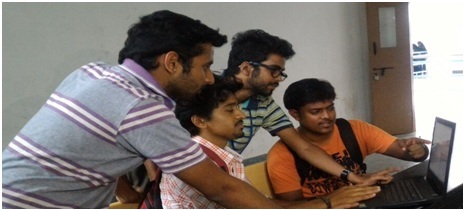
Team Members : Santhosh M. P, Srivatsa M, Venkatesh N.
Project Guide : Mr. Omar Khan Durrani
Abstract of the project:
This project presents a novel approach for Human Computer Interaction (HCI) where, cursor movement is controlled by using a real-time camera. Current methods involve changing mouse cursor using a hardware device (say mouse) or a more recent method uses colour tape held by hand to detect mouse cursor position. Instead, proposed method uses a camera and computer vision technology, such as image segmentation and gesture recognition, to control mouse tasks (left and right clicking, double-clicking, and scrolling).Recognition and position estimation in this system are user independent and robust as skin detection methodology is used to identify position of hand and thereby performing respective actions. The main idea is to continuously take the live feed from the web cam and apply image processing methodologies to calculate the position of hand. The system does not rely on any additional hardware other than the camera which makes it simpler to use compared to the use of projectors, colour bands, gloves etc.
Team Members : Nikitha Tata B., Devanga Rakshitha, Jaswanth B. J., Manu S. Herle
Project Guide : Mr. Aditya C. R.
Abstract of the project:
Tracing is a specialized use of logging to record information about a program's execution. This information is typically used by programmers for debugging purposes, and additionally, depending on the type and detail of information contained in a trace log, by experienced system administrators or technical support personnel and software monitoring tools to diagnose common problems with software. The objective is to build an application using C# and Visual Studio .Net that produces a detailed trace report of execution as output in a user friendly format. i.e., elaborates the steps of the program thus making its working, easy to understand, for the program written using the specified subset of C language. The application will help in understanding the program logic and help in the identification of logical errors in the program (if any). The input is a program written in C Language. The program should be in the form of a file. Syntax directed translation schemes and Novel intermediate code generation algorithms are designed for implementing the tracer. The testers can check if the program is working as expected for every test case designed by using this application. The application also helps in understanding the cause of the error (logical) and assists in correctly fixing it, since the step by step trace gives a clear picture of what the program does as opposed to what it is supposed to do.
Team Members :Manegar Faizan Ahmed, Pavan A.C., Raghu R., Darshan C.M.
Project Guide : Mr. Madhusudhana G. K.
Abstract of the project:
The goal of project is the development of an electroencephalogram (EEG) based brain computer interface (BCI) system. The user thought is extracted from the brain activity of a healthy person, Pre-processing is performed using filters and wavelet transforms to extract the desired features. Decomposed samples are classified into predefined human activities using neural network. The intention of this work is to enhance human interaction with computers, providing a communication channel between human brain and computer. Patients who suffer from severe motor impairments and are unable to speak may use such an EEG based BCI system as an alternative form of communication by mental activity.
Team Members : Manegar Faizan Ahmed, Pavan A.C., Raghu R., Darshan C.M.
Project Guide : Mr. Madhusudhana G. K.
Abstract of the project:
Innovation in communication and information technologies have caused a revolution in values, knowledge and perceptions in practically all areas of human understanding, deeply carving the so-called “Age of Information and Knowledge”. Human beings have invented/adopted technology to their needs since their existence. Main purpose of innovation in technology, irrespective of the domain, has been in simplifying life on earth or making every day’s work easier and faster. One regular task that human beings spend considerable amount of time is in shopping.
Motivation:
According to a survey conducted by US Bureau of Labor, on an average, human beings spend 1.4 hours every day on shopping. A survey done by Visa in 2005, points out an amazing fact that 70% customers will walk out of a queue if the line is too long, and 10% are “seriously annoyed” the moment they step in a queue. Further, according to a study conducted by CISCO Internet Business Solution Group, the top four reasons for shoppers to use technology are to (i) Find best price (63%), (ii) Save time (47%), (iii) Find best assortment (26%) and (iv) Find best quality (25%). The current scenario on shopping classifies it into two categories (1) Shopping in-person and (2) Shopping in absentia. Shopping in absentia is facilitated in multiple ways including, internet shopping, tele-shopping, etc. wherein a shopper does not have to be physically present in the shopping area. Shopping in-person typically involves a personal visit to the place of shopping and selecting the product/s based on various parameters including need, convenience, brand, discount/offer, etc.
Scope:
The project is about adding smartness to the shopping carts used in shopping malls in order to reduce human effort, enhance the shopping experience and to smartly recommend customers with offers on the products which they are going next.
Here human effort is reduced as cart automatically detect the customer with the help of a camera and follows everywhere the person goes which eliminates the need of pushing/pulling the cart
For recommending the offers a machine learning algorithm is used, which when provided with a huge set of data pretty accurately predicts the products which the customers are going to buy next. LCD display is used to display the customers with offers and suggestions.
The cart’s inbuilt automatic billing system makes shopping a breeze and has other positive spin-offs such as freeing staff from repetitive checkout scanning, reducing checkout time of customer and increasing operational efficiency of the system. The system helps the store management with an automatic update of the inventory on every purchase of an item Intelligent shopping cart (proposed system) has the potential to make shopping more pleasurable and efficient for the shopper and the inventory control easier for the store management.
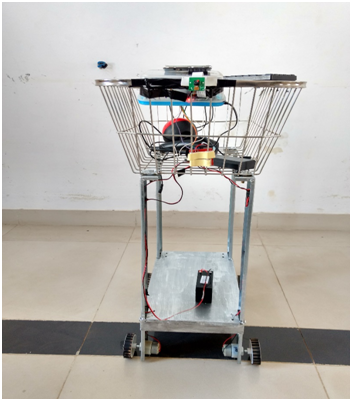
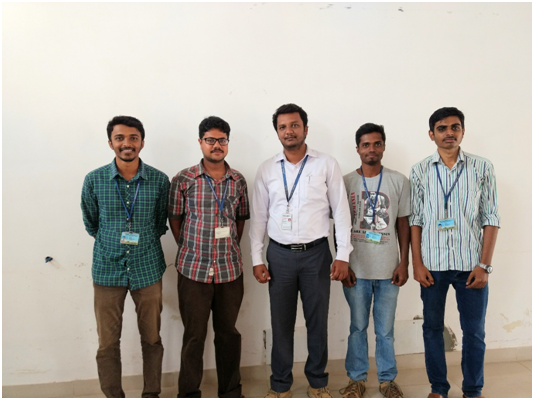
Team Members : Mr. Bharath Kumar K R, Ms. Bhavitha S , Ms. Nikath Fathima , Ms. Sushmitha B
Project Guide :Mrs Rumana Anjum, Assistant Professor.
Abstract of the project:
It is indisputable that telecommunication is a vital requirement in the contemporary culture. Despite the significance of cell phones in these contemporary times, there are a number of settings whereby the public use of cell phones creates an unbearable feeling on other people, especially in places that require absolute silence and concentration. It is not practical to completely ban the use of cell phones in public places. Thus it will be better to allow usage of mobile devices in public places but with some restrictions such as controlling its features such as disabling camera, changing general mode to silent or vibration mode, play alert tone etc.
Introduction :
Conventional ways of enforcing prohibition uses signage (signs) to communicate or to convey information so that the viewer may make cognitive decisions based on the information provided. Some of such signs are no photography, usage of mobile phones prohibited, no loud ringtones etc. But most often these signs are taken for granted by the people and the regulations are not respected. The Bluetooth Low energy (BLE) beacons broadcasts tiny radio signals over the air containing unique, location specific data. Modern smartphones constantly scan for these signals. If they enter their range the ‘Broadcast-Receiver’ component of the android device triggers an associated application. This application responds by performing the desired action.
Admin selects the predefined option (Silent/ Vibrate/ Alert/ Disable camera) in ProhiBeacon1 application. Prohibeacon1 broadcasts a unique UUID corresponding to the selected prohibition type. While ProhiBeacon2 receives the broadcasted UUID and switches from normal mode, to the mode specified by admin. Normal mode is restored once Prohibeacon1 moves out of range.
Applications :
Our project has won the Best Paper award in the National Conference On Innovations and Discoveries in Engineering and Technology , conducted on 18th May 2017.
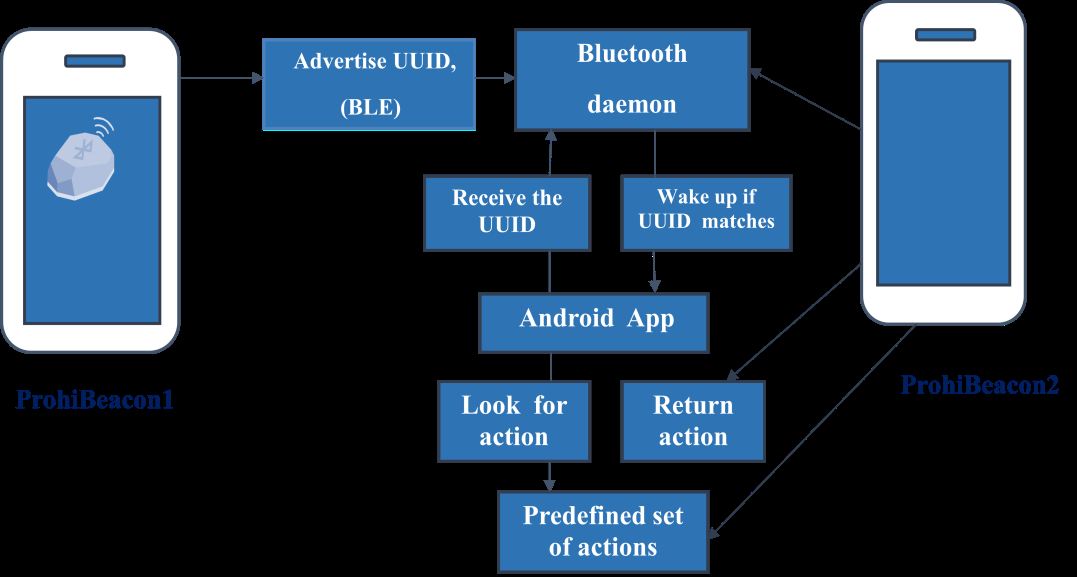
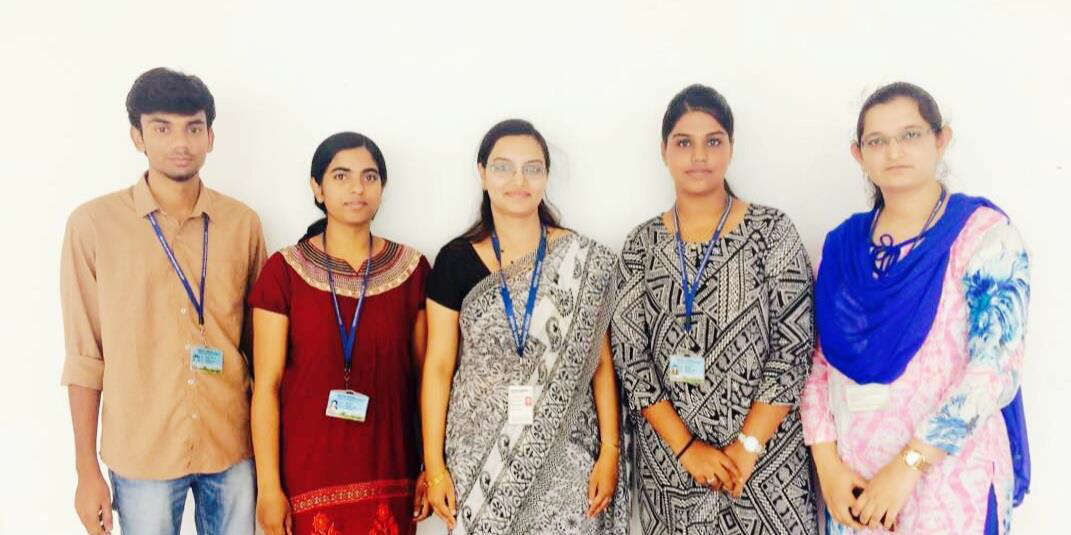
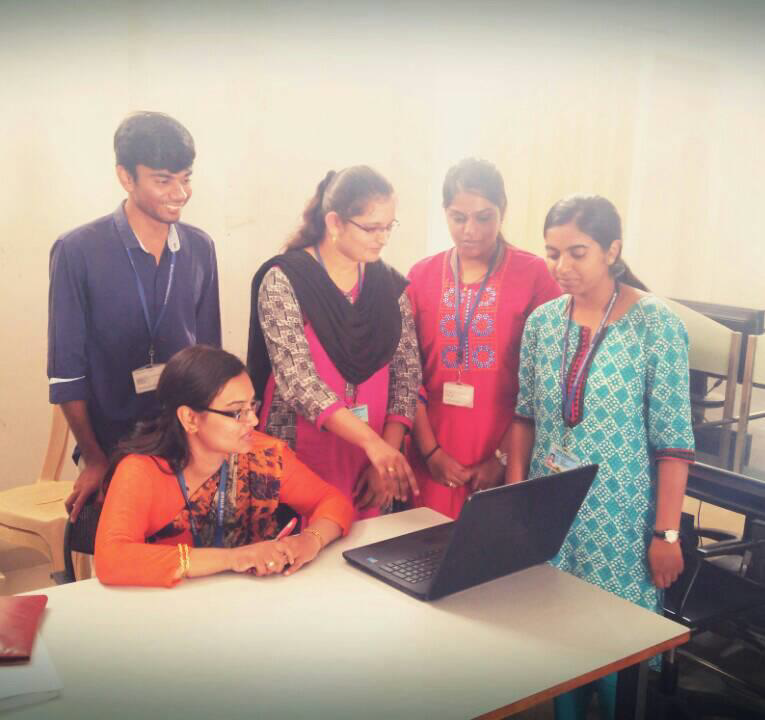
Team Members : Mr. Bhargav A V Rao, Mr. B K KiranKumar , Mr Puneeth B K , Ms. Sindhu Y G
Project Guide : Mr. Aditya C R, Assistant Professor
Abstract of the project:
Face recognition is a video analytics system and is an interesting field of research in computer vision. It is widely used in applications of person identification for the identity in Government and Private organization for security and intelligent services. The development of real time face recognition system is still a challenging task and the major difficulty lies in extracting the features from the video sequence with heterogeneous background. The main idea here is to develop a system based on image processing technique to detect and recognize the known face to mark attendance against the students in the classroom using video camera. This task is achieved by creating a single frame work to detect the face by extracting features and to recognize the detected face using supervised learning algorithm. The features extracted in the project characterizing the face are Haar like features which is used to train the series of weak classifiers called cascade classifiers. A LBPH (Local Binary Pattern Histogram) descriptors are extracted from the face detected by the cascade classifiers to train and test LBPH classifier. The recognized face is used to mark the attendance and it is tabulated in the file against their names.
Introduction :
Face recognition is one of many applications of digital image processing. It is concerned with the automatic identification of an individual in a digital image. The need to maintain security of information and physical property is becoming both increasingly important and difficult. Therefore, the need for technology to allow verification of “true” individual identity has emerged. This technology is based on the field of “Biometrics”. Biometric access control is automated method of verifying or recognizing the identity of a living person on the basis of some physiological characteristics, such as fingerprints or facial features. Face recognition is one of the few biometric methods that possess the merits of both high accuracy and low intrusiveness. It has the accuracy of a physiological approach without being intrusive. For this reason, since the early 1970's face recognition has drawn the attention of researchers in fields from security, psychology, and image processing, to computer vision
Applications :
Real time recognition makes it possible to apply in college campus, specifically in classroom so as to mark attendance.
Our project has won the Best Paper award in the National Conference On Innovations and Discoveries in Engineering and Technology , conducted on 18th May 2017.
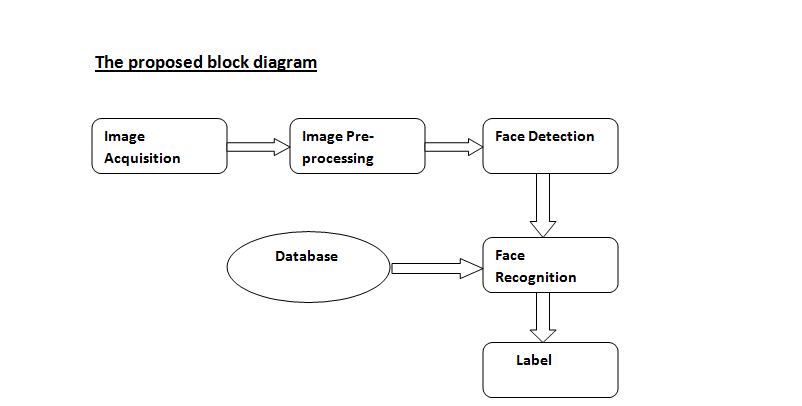
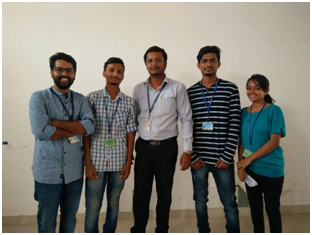
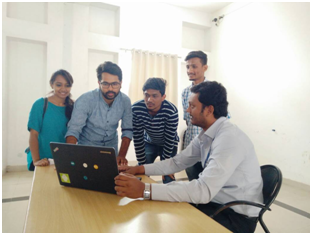
Team Members : Mr. Bhargav A V Rao, Mr. B K KiranKumar , Mr Puneeth B K , Ms. Sindhu Y G
Project Guide :Mr. Aditya C R, Assistant Professor
Abstract of the project:
We are proposing a model system for smart question paper generation and secure distribution of question papers in Universities. The system provides a platform for faculties to register themselves only if they are authorised faculties of respective universities. Registered faculties are allowed to create question papers in their respective specializations within the stipulated time given. The question papers set are further scrutinized by the scrutinizing committee in order to ensure that the questions in the question papers are bound within the limits of the given syllabus. Higher authority of the university generates a random question paper on the day of examination. The randomly generated question papers are then sent to the respective institutions safely before an hour of the examination. Institutions are allowed to receive the question papers only through the systems which are granted with permission from the university.
Introduction :
In today’s world, time is a major concern. Any product that can effectively reduce time and power consumption is accepted and appreciated. Thus we are presenting an Automated Question Paper Generator System that can reduce time consumption by replacing the conventional method of question paper generation system.
In our project we present a smart question paper generating system. Here we allow university registered professors to register themselves to the system using their name, e-mail id, subject, year, experience, college name to prepare question papers for the concerned subjects. Once they register, a confirmation e-mail will be sent to the registered email-id which consists of their user id, password, and the time slot allotted for that particular day. The registered person must set the paper within that time period and within that time slot he can login any number of times. Once the question paper is set it will be viewed by the scrutinizer. The scrutinizer who monitors the system, also analyze these questions and selects 3 question papers which are to be sent to the examination officer/Registrar. The examination officer/Registrar will generate a question paper from the set of three question papers sent by the scrutinizers. The question paper generated is sent to the institutions. Institutions can access this question papers only from the systems whose IP addresses are verified by the university. Institutions can download the question papers sent by the examination officer/Registrar only if they have the access codes sent to their respective email-id.
Applications :
Question paper processing and distribution system is a web-based, secure application for sharing confidential question papers of the universities. The application will be robust and makes sharing of documents extreme. It will be having fully equipped user management system. It reduces the man power involved in the manual question paper generation process. It helps to save the time delay of question paper setting members. Question papers will be delivered in a highly secured manner using secure access codes to the examination centers. At the examination center also, only authorized person/s will use their security to decrypt and then print using high speed printers. Hardware based authentications further ensure the whole process is highly secure and fool-proof. In this paper we are proposing a model system for smart question paper generation of Universities. The main objective of this system is to provide service which is reliable in terms of duplicity removal, uncompromised issues, and lesser man power which makes it easy to import the question papers as per requirements. The Question Paper Setting task can be done by 10 registered professors simultaneously using the login credentials and the admin can have as many question bank resources he/she want in the database for future use. And can divide them subject-wise as per convenience. The mechanism behind this system is that many random question papers are generated by the faculties. Here in our project we are providing powerful security strategy at different levels.Advantages of Proposed System are Here in our project.
Data leakage is avoided to maximum extent. Time constraints allow the process to complete on time, which helps in delivering the question papers on time for further processing.
Random generation of question papers avoids theft of data, even the author of that particular question papers will not know the questions present in the final question paper automatically generated by the examination officer/ registrar.
Secure distribution of question papers plays an important role in having the confidentiality of distribution.
IP address verification avoids in sending the question papers to the systems which are not authorized by the universities
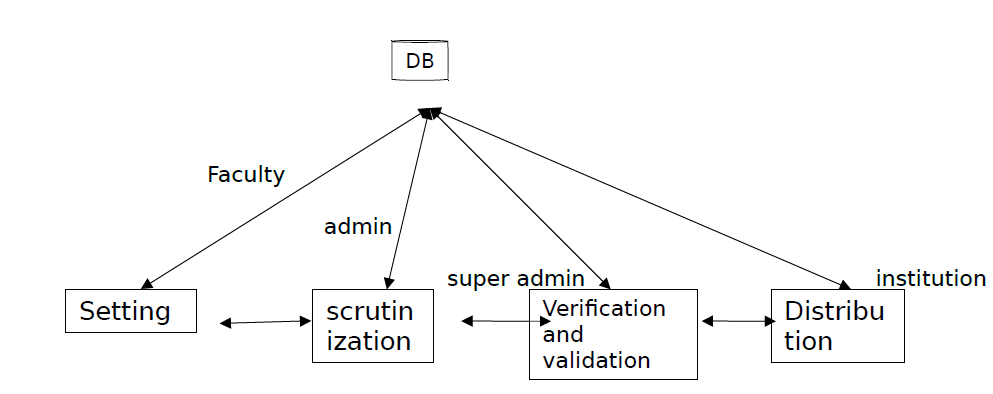
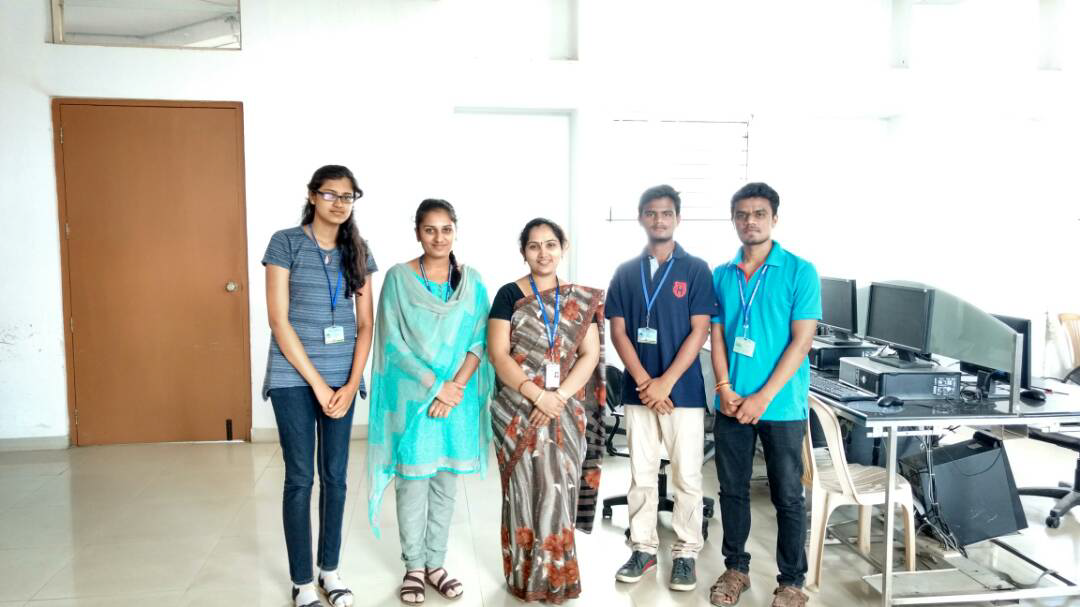
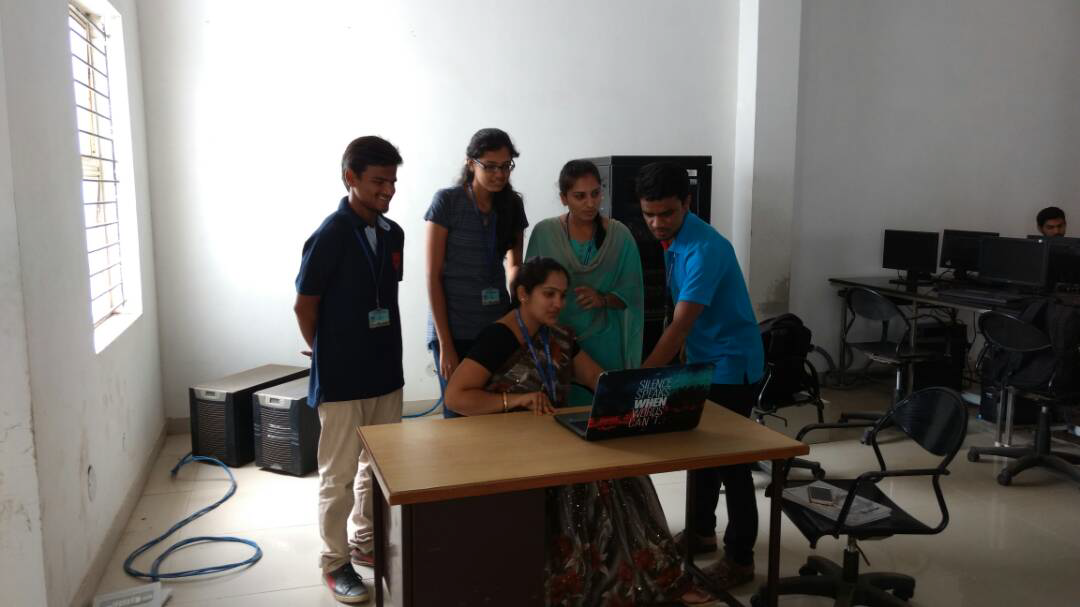
Take a short tour in our campus